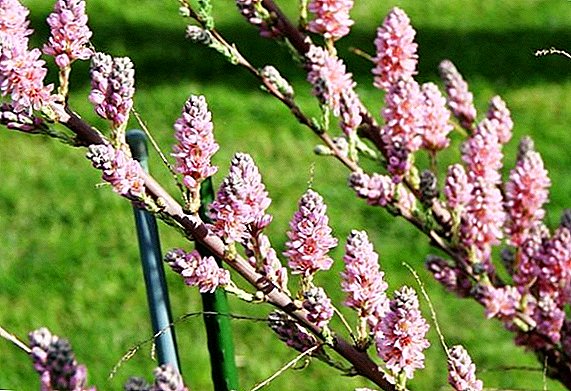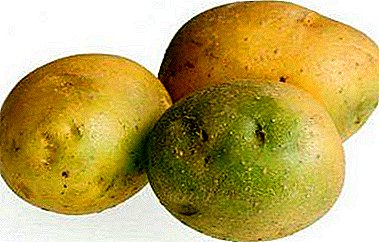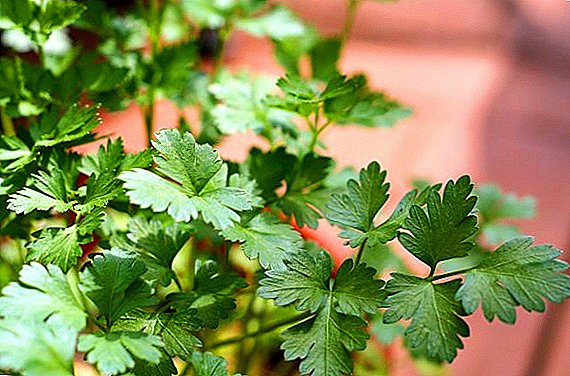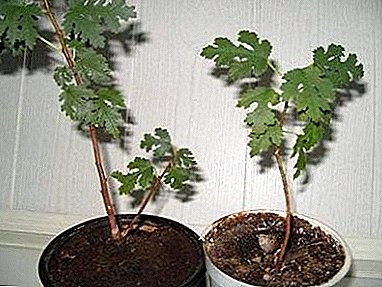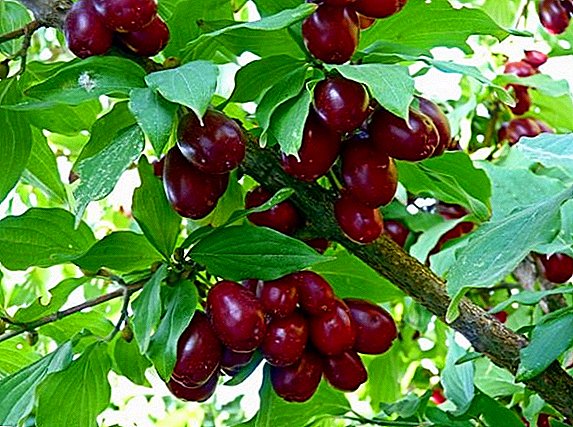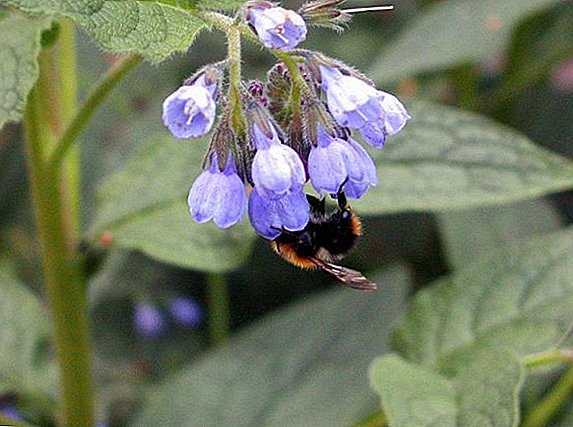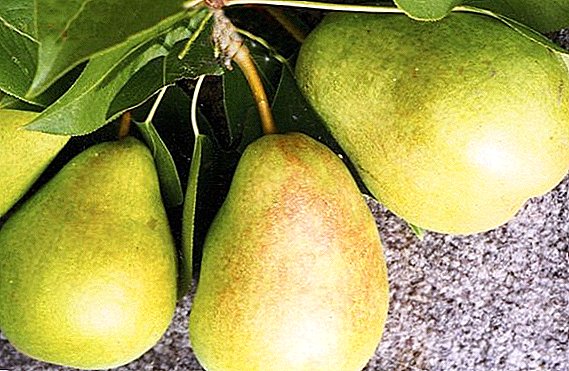 Everyone knows that gardeners are hard-working people and inclined to experiment. This is also evident in many areas in which familiar species and varieties coexist with rare crops sampled. And often such tests give tangible results. One of these plants is chufa, which is worth a closer look.
Everyone knows that gardeners are hard-working people and inclined to experiment. This is also evident in many areas in which familiar species and varieties coexist with rare crops sampled. And often such tests give tangible results. One of these plants is chufa, which is worth a closer look.
Description
Chufa (also earthen almonds, or edible syt) looks like a wild sedge. It is a dense bush of medium size: it grows to a height of 30-90 cm.  Straight thin stems of a trihedral form in cross section release the leaf bundles, each of which has about 3-11 leaves 3-10 cm wide. Small bisexual flowers are collected by an "umbrella" - the nondescript brown color is pollinated by the wind.
Straight thin stems of a trihedral form in cross section release the leaf bundles, each of which has about 3-11 leaves 3-10 cm wide. Small bisexual flowers are collected by an "umbrella" - the nondescript brown color is pollinated by the wind.
Learn about the beneficial properties of such nuts as macadamia nuts, pecans, pistachios, pine nuts, brazil nuts, hazelnuts, cashews.But the main difference of this species is, of course, the rhizome. It is well developed: stolons start from the roots, studded with numerous small nods, similar to nuts.
With a length of up to 3 cm and a width of up to 1, these processes resemble almond nuts to taste, due to which the species got its second name. The white flesh of the tubers is sweet and rather hard.
Its color varies from rich brown to pink or yellowish, and transverse grooves in the amount of 3-6 pieces are visible on the surface. 
Important! The furrows are most clearly manifested during storage - the surface of freshly harvested fruits will be smoother to the touch.
The plant came to us from Italy and Spain, where it came from North Africa - in the primary range, chufa was eaten as far back as 4,000 years ago (this was a delicacy of Egyptians, residents of Morocco and Sudan).
Earthen almonds are not particularly demanding to the soil, but still the best yields are removed from fertile and loose soils - in such conditions, the roots can produce 400-800 (and even up to 1000) round tubers.
In temperate latitudes, chufa is cultivated as an annual plant, whereas in a warm climate, the period of rapid flowering and fruiting begins in the second year. 
Composition
Per 100 g of this product have:
- 18.6 g of proteins;
- 53.7 g of fat;
- 13 g of carbohydrates;
- at least 10 g of starch;
- some water and dietary fiber, among which primacy over fiber.
Such a structure of nutritional value is also reflected in calorie content - 609 kcal / 100 g. It turns out that chufa is three times higher than almonds in this indicator, and 150 g of product per day completely cover the daily need for vegetable fats (nutritionists say that in plant acids).
Did you know? In ancient Egypt, chufa leaves and roots were used to refresh and flavor the house and garments.

If you look closely, it turns out that the tubers also contain:
- vitamins A, B, C, E (most of the substances in group B);
- lipids;
- oleic acid omega-9;
- iron and zinc;
- other trace elements in the form of copper and potassium, selenium and iodine, calcium and phosphorus, as well as sodium.
From such a valuable product by cold pressing get a healthy oil, the properties are not inferior to the olive, but with a distinct almond flavor. 
Beneficial features
Chufa has a number of useful properties, among which stand out:
- improvement of the activity of the brain and muscles (the great vessels are brought in tone);
- tonic effect, resulting in a surge of strength and increases efficiency;
The use of a large sedum, padubal mahonia, rosemary, onions, oranges, lettuce, pine cones has a tonic effect.
- as a natural antioxidant, earthen almonds remove toxins, heavy metal salts and radionuclides from the body (both in raw form and when nuts are added to tea);
- dilation of blood vessels, reducing the risk of thrombosis and atherosclerosis;
- lowering blood sugar and excess cholesterol in the blood;
- strengthening the bone apparatus;
- improving immunity - as an element of tinctures, chufa helps fight colds;
- normalization of digestion due to antibacterial action;
Normalize digestion products such as sunberry, zucchini, Jerusalem artichoke, white beans, apricot, dogwood, arrows of garlic, cherry, apples.
- support of the nervous system - nervousness disappears when consumed, symptoms of overstrain are removed.
Important! The greatest benefit comes from parts of the plant growing on clean, not oversaturated with fertilizers and pesticides soil.
 Note the healing abilities of the oil. It is a powerful antiseptic, and when applied to the skin penetrates deep into the cell layer - as a result, the aging of cells is inhibited, and the skin becomes more elastic and softer.
Note the healing abilities of the oil. It is a powerful antiseptic, and when applied to the skin penetrates deep into the cell layer - as a result, the aging of cells is inhibited, and the skin becomes more elastic and softer.This raw material not only nourishes the skin, but also helps maintain healthy hair and nail growth.
Growing up
After reading the list of useful qualities of this species, many are immediately interested in how to grow this plant on their own.
Nothing complicated: prepared tubers or pre-grown seedlings are planted in open ground. To do this, use the whole fruit (try to take larger). The selected material is washed, treated with a solution of potassium permanganate 5% and washed once again, dried.  Making sure that the nodules are dry, they are placed in a glass jar covered with a lid, and the container itself is placed in a cool place with stable + 4 ... +7 ° С.
Making sure that the nodules are dry, they are placed in a glass jar covered with a lid, and the container itself is placed in a cool place with stable + 4 ... +7 ° С.
The process itself does not conceal any special tricks for an experienced gardener, but there are still some nuances. Consider them, knowing exactly how the landing chufa looks in our latitudes.
Landing
Before landing in open ground roots stand for 2-3 days in water at room temperature, not forgetting to replace it 2 times a day.
Did you know? In the Paris Chamber of Measures and Scales, a cubic meter of black earth is stored, which is a standard of fertility.
 This is done in mid-late May, when the threat of frost finally passed (the air temperature does not fall below + 13 ... +15 ° C), and the soil in the upper layer managed to warm up to + 12 ° C.
This is done in mid-late May, when the threat of frost finally passed (the air temperature does not fall below + 13 ... +15 ° C), and the soil in the upper layer managed to warm up to + 12 ° C.It all starts with the selection of a suitable site:
- Chufa loves light, loose and nutritious soils, although it will get along well in heavier areas. The main thing - the bush should grow in open space (shaded corners of the garden are not suitable);
- in one of the places with good lighting, dig holes dug 6-8 cm;
- filling them with a small amount (up to 2 liters) of water, and letting the moisture soak slightly, 3 tubers are laid in each hole — something like a nest is obtained. The distance between the holes should be about 40-50 cm (if you take a smaller interval, the bushes simply interlock). Between the rows leave 60-65 cm;
- it remains to fill the hole with earth, lightly tamping them.
 In good weather, shoots will fight off after 10-14 days.
In good weather, shoots will fight off after 10-14 days.It happens that at the very end of May the temperature starts to drop to +10 ° C, and strong winds blow.
In such cases, immature youngsters are covered with a film stretched over the arcs.
To prevent the plants from caking, they are aired by removing the coating during the day. With the onset of summer, it is no longer necessary.
Important! Pay attention to the depth of groundwater: the lower they pass, the better for earthen almonds (waterlogging causes rotting of the root crop).
Many practice landing seedlings - In regions with a cool climate, this is the only guarantee of harvest. 
Algorithm bookmarks, usually conducted in early or mid-April, looks like this:
- the tubers are kept for a day in barely warm water (during this time it is necessary to change the liquid twice);
- while the material is soaked, ground is prepared. In a pot with a height of 8-10 cm or bulk cassette poured the soil and prepare fertilizer. To do this, you need superphosphate (10 g per seat), urea (6 g), potassium and magnesium sulfates at a dose of 5 and 2 g, respectively;
- Tubers are laid in a moist soil to a depth of 6 cm and sprinkled with earth;
- capacity put in a warm place. The temperature regime is extremely important for the thermophilic type: in the daytime the air in the room should warm up to + 20 ... +25 ° С, and at night - not to fall below +15 ° С. If the house is cool, the pots are covered with a film, opening it for ventilation;
- a significant role is given to the light: in a short day (for example, in the northern regions) you will have to put a lamp for illumination;
- Moderate watering is done every 3-4 days, until sprouting only spraying is used. With the same break, the soil is gently loosened - so the roots will receive the necessary portion of oxygen;
- before transplantation into the open ground one-time feeding is obligatory. In 10 l of water add bird droppings and mullein in proportions 1: 7 and 1: 3. Superphosphate (15 g), potassium sulphate (8 g) and ammonium nitrate in a dose of 7 g are also sent there. The prepared mixture should be absorbed into the soil, but should be added very moderately so as not to overmoisten, or worse, not to burn sensitive roots;
- about 10 days before moving to open soil, the shoots are hardened: the temperature is lowered to +15 ° C, the number of waterings is reduced. This will accelerate the adaptation of plants on the site.

Did you know? Before the “corn epic”, food syt was part of the USSR agricultural program.
As you can see, there is nothing super-complicated. All further agrotechnology in the form of care is also considered fairly simple.
Care
Watering requires a one-time, in dry weather - twice a week. In rainy weather, you can do without it, correcting the mounds in the holes and carefully loosening the soil around. More thorough hilling done 2 times per season: when the stalks grow to 10-15 and 30 cm.
Top dressing held 3 times, with breaks of two weeks. To do this, use mineral fertilizers with a low concentration of nitrogen - its abundance will cause rapid growth of green mass, which "draws" all the useful substances from the rhizome.
Choose the most suitable mineral fertilizer: Ammophos, Plantafol, Sudarushka, Azofoska, Kristalon.Many do without the "chemistry", with the same frequency of bringing under the bushes of 1 liter of green infusion of herbs or mullein.

Pest control It is desirable to reduce to the use of improvised compositions like soap solution (the popular Bordeaux liquid is too strong for this culture). As needed, preventive powders are made - special granules will be pushed away from the chufs of ants and bears, which are attracted by these bushes.
Another pest is a wireworm: it usually shifts from vegetable plantations, and then insecticides like Bazudin, diazonin and Celeste TOP must be used.
Important! Using these chemicals, read the instructions, especially the dosage section for different crops.
In mid-late September or early October, the leaves begin to turn yellow and dry - it's time harvesting. The nodules are dug with garden forks, cleaned from the ground, washed and dried in the sun to a moisture content of 10-15%.  Seeing that they have appeared characteristic grooves, the harvest is sorted. Whole nuts are placed in a cardboard box or bag: they can be stored both in the room and in the basement or in the attic (if there are, of course, no rodents).
Seeing that they have appeared characteristic grooves, the harvest is sorted. Whole nuts are placed in a cardboard box or bag: they can be stored both in the room and in the basement or in the attic (if there are, of course, no rodents).
Over time, this material will become overloaded and wrinkled. Do not worry: germination lasts up to 3 years. Medium-sized fruits are usually laid on seedlings, which are soaked in water the day before.
All this is good, but here's the process. cleaning very time consuming because of the dense skin. Leaving it is not advised: the taste is lost. To avoid this, freshly harvested tubers are washed and placed in clean water for several hours. And then - how much patience will anyone have: the fruits are frayed until most of the peel is separated.
With a large crop, there is not always time for such manipulations, therefore, during storage in the peel, the nuts dry out, halving in size. Therefore, before further processing or ingestion, they are soaked for 1-2 days. 
Did you know? Drink of orchata (or orshata), the constant ingredient of which are these nuts, is considered one of the gastronomic symbols of Spain.Concerning wintering, then in domestic conditions it is practiced extremely rarely - not the climate. Surviving the winter of chufa with cut tops can only be in a heated greenhouse or in a hole, sprinkled with a small amount of humus mixed with a thick (about 9-10 cm) layer of mulch from autumn.
Contraindications and harm
Among the direct contraindications to use are:
- individual intolerance;
- liver disease;
- obesity.
For obesity, it is recommended to use rapeseed honey, turnips, asparagus beans, blackberries, pine sap, beets, lespedets.With moderate use (no more than 100-150 g per day), the product is practically harmless. Although this amount can play a cruel joke with people prone to rapid weight gain, nuts are very high in calories.
 Particular caution should be followed by those who have not tried such dishes before: during the first tests they try to take at least fruits.
Particular caution should be followed by those who have not tried such dishes before: during the first tests they try to take at least fruits.This will provide an opportunity to follow the reaction of the body and do not harm the stomach, still not dealing with such products. Brute force is fraught with short-term diarrhea.
Application
The plant is widely used in various fields.
The first thing that comes to mind is ethnoscience. The most popular recipes are reduced to obtaining decoctions and drinks, infusions and spirit tinctures from crushed tubers. Leaves are added to medicinal tea. 
Important! Having landed chufu on the "frontier" of the summer cottage, convince the neighbors that this is not a weed, as it may seem at first glance. Such similarity unknowingly leads to the destruction of plants.
All these tools are used as immunomodulators and tonic compounds, strong antibacterial and sedative drugs. Moreover, it is also a powerful adaptogen capable of supporting the body during recovery from an illness or surgery.
AT cooking Chufa valued for the taste of the fruit. They are readily included in recipes for homemade sweets - halva, pies, muffins, etc. From roasted and ground nuts make a natural energy drink.
Manufacturing perfumery It also does not do without mini-nuts, the processing products of which (mainly oil and extract) give the spirits and fresheners fine almond amber.  Known chufa and beauticians: If you get an insight into the composition of lotions, creams and shampoos, many of them have this ingredient in a processed form. And quite deservedly: in terms of hair healing and skin rejuvenation is considered one of the most effective plants.
Known chufa and beauticians: If you get an insight into the composition of lotions, creams and shampoos, many of them have this ingredient in a processed form. And quite deservedly: in terms of hair healing and skin rejuvenation is considered one of the most effective plants.
AT industry Not only the tubers used by confectioners to make powders and powders, chocolate and bars are used. No less than the "professions" and the leaves - they are present in the technological chain of paper making, insulation coatings, phyto-fuels, tows, ropes and bedding.
Did you know? Archaeologists believe that chufa was the basis of the diet of the ancestors of modern people who lived in Africa 2 million years ago.
 Livestock - Another application of this plant. As hay, the ground part is comparable to cereal grasses (horses love it very much). Boiled fruit with feed can be given to pigs.
Livestock - Another application of this plant. As hay, the ground part is comparable to cereal grasses (horses love it very much). Boiled fruit with feed can be given to pigs.Now you know what chufa is, how valuable it is, and how to grow it in your area. We hope this plant will appeal to our readers, and will bring them a lot of benefit. Record harvests!


